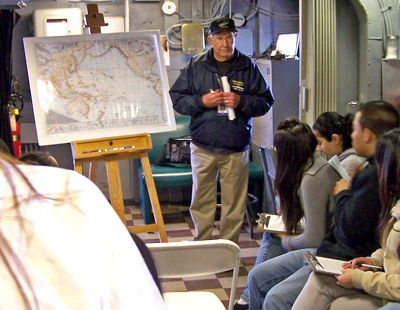
The USS Hornet Museum in Alameda is a historical treasure that has evolved into a hands-on learning place where students learn about history, science, technology and math. Among the educational programs offered at the war veteran aircraft carrier is STEM (Science, Technology, Engineering, Mathematics), which provides the opportunity for local schools to not only experience history firsthand, but also learn how science, math and technology all play a vital role in the day-to-day activities aboard the massive ship.
The goal of each Hornet educational program is to use the unique, stimulating environment of the historic aircraft carrier to teach science and history concepts in an interesting, interactive, fun manner. One of the programs is held during an overnight stay on the ship.
"What I liked best about the program was sleeping aboard a World War II aircraft carrier,” said one student.” I also enjoyed the engine room tour and the ghost stories.”
As part of the educational programs, students have the opportunity to walk on the flight deck where fighter jets left for missions during Science, Technology, Engineering, Mathematics. They also will stand inches away from the Apollo capsule that took man to the moon.
“It´s a great learning opportunity, but also has the potential to spark the curiosity of youth and perhaps inspire them to a career in technology, science or engineering,” said Hornet spokesperson Victoria Sánchez De Alba.
“We all know the best jobs are currently in the science and technology fields and what better ways to grab children’s interest than by having them see it in action,” she adds.
The Hornet participated in World War II, the Vietnam War, and the first moon missions. It is one of the most decorated ships of the US Navy. The ship was under air attack 59 times but was never seriously damaged.
Records of how many Hispanics served on the USS Hornet were not immediately available, though Hispanic-American participation in the big war is well documented. Hispanic Americans fought in every major battle in the European Theatre of World War II. According to the National World War II Museum, between 250,000 and 500,000 Hispanic Americans served in the U.S. Armed Forces during World War II. On December 7, 1941, when the United States officially entered the war, Hispanic Americans were among the many American citizens who joined the ranks of the Army, Navy and Marine Corps as volunteers or through the draft.
Honoring our heroes: 9/11 remembrance on board the USS Hornet Museum
In commemoration of the 10 year anniversary of 9/11, the USS Hornet Museum will pay tribute to San Francisco Bay Area First Responders during a special ceremony on Saturday, Sept. 17 during Living Ship Day.
The special memorial service begins at 1 p.m. and will be led by Hornet Chaplain John Berger, a WWII veteran and Bronze Star recipient. Following the service a wreath will be tossed into the water to commemorate those who lives were lost.
The public is invited to this special ceremony. Among the numerous activities scheduled to following the ceremony are a big band performance by the Hornet Band, rescue demonstrations, activities for the children and much more.
During Living Ship Day, the museum comes to life as an operating aircraft carrier with flight simulations between 11 a.m. and 3:30 p.m. as aircraft are lifted to the flight deck and placed into launch position. Visitors can meet former crew, sit in the cockpit of a fighter jet, and enjoy the sights and sounds of naval aviation.
Living Ship Day demonstrations are held on the third Saturday of most months. The USS Hornet Museum is located at 707 W Hornet Ave, Pier 3 in Alameda.
